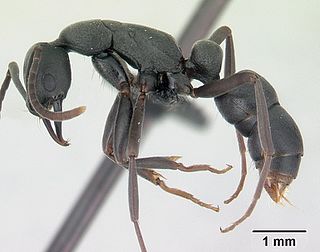
The Formicinae are a subfamily within the Formicidae containing ants of moderate evolutionary development.

Ponerinae, the ponerine ants, is a subfamily of ants in the Poneromorph subfamilies group, with about 1,600 species in 47 extant genera, including Dinoponera gigantea - one of the world's largest species of ant. Mated workers have replaced the queen as the functional egg-layers in several species of ponerine ants. In such queenless species, the reproductive status of workers can only be determined through ovarian dissections.

Myrmicinae is a subfamily of ants, with about 140 extant genera; their distribution is cosmopolitan. The pupae lack cocoons. Some species retain a functional sting. The petioles of Myrmicinae consist of two nodes. The nests are permanent and in soil, rotting wood, under stones, or in trees.

Crematogaster is an ecologically diverse genus of ants found worldwide, which are characterised by a distinctive heart-shaped gaster (abdomen), which gives them one of their common names, the Saint Valentine ant. Members of this genus are also known as cocktail ants because of their habit of raising their abdomens when alarmed. Most species are arboreal (tree-dwelling). These ants are sometimes known as acrobat ants.

Dolichoderus is a genus of ants found worldwide.

Leptogenys is a genus of ants in the subfamily Ponerinae. Leptogenys is the most diverse ponerine ant genus in the world; it is widespread throughout tropical and subtropical regions and there are over 260 extant species described. Most species have ergatoid queens, and many have falcate, bowed mandibles and are specialists on isopod prey.

Ponerini is a tribe of Ponerinae ants with 46 genera and 6 extinct genera.

Diacamma rugosum, also known as the Bornean queenless ant, is a species of ant of the subfamily Ponerinae. It is found in many countries throughout Southeast Asia. 20 subspecies are recognized.

Leptogenys diminuta is a species of ant of the subfamily Ponerinae. Twelve subspecies are recognized.

Leptogenys falcigera, is a species of ant of the subfamily Ponerinae.
Leptogenys hysterica, is a species of ant of the subfamily Ponerinae. It is found in Borneo, India, Sri Lanka, and Thailand.
Leptogenys meritans, is a species of ant of the subfamily Ponerinae. It is found in Sri Lanka.
Leptogenys pruinosa, is a species of ant of the subfamily Ponerinae. It is found in Sri Lanka, and Philippines.
Leptogenys peuqueti is a species of ant of the subfamily Ponerinae. It is found in India, Sri Lanka, China, Vietnam, and Philippines.
Leptogenys yerburyi is a species of ant of the subfamily Ponerinae. It is found in Sri Lanka, and China.









